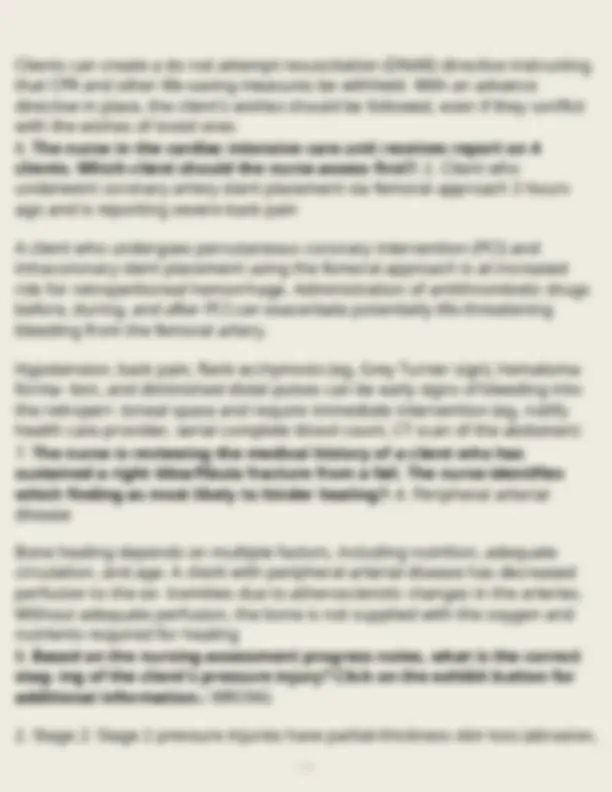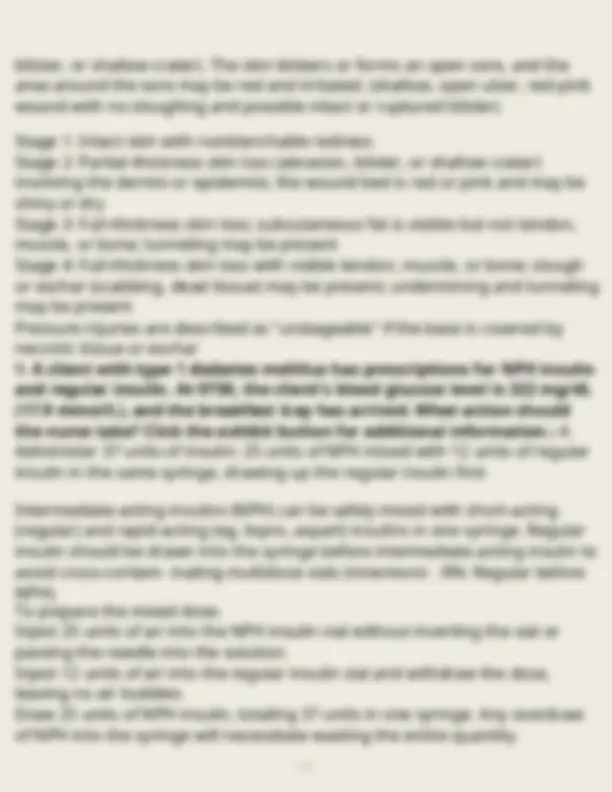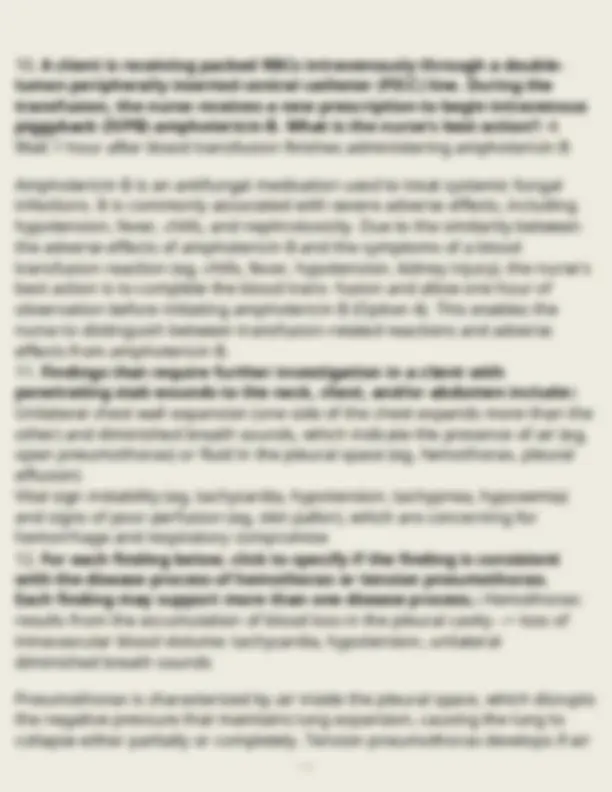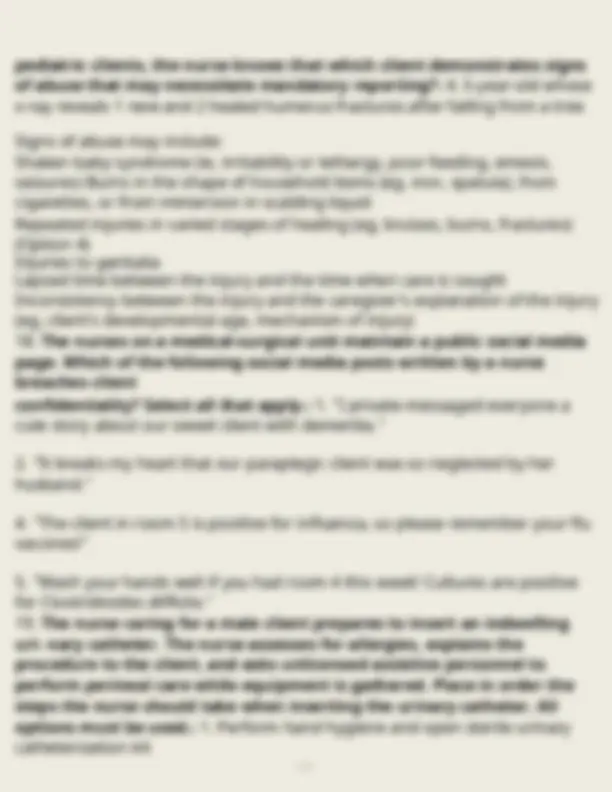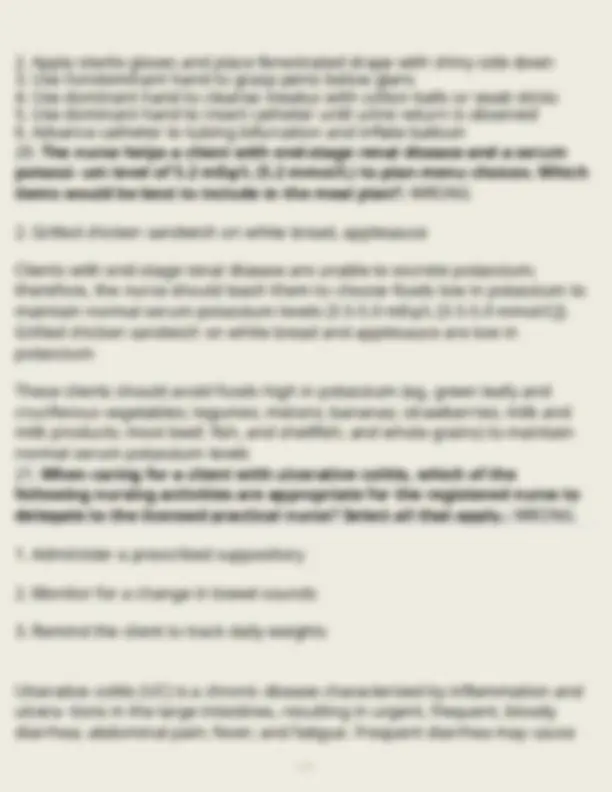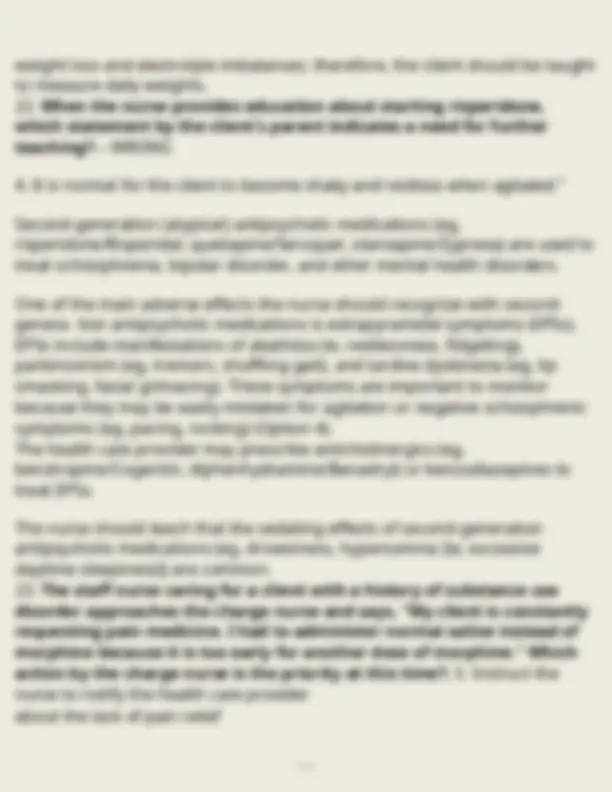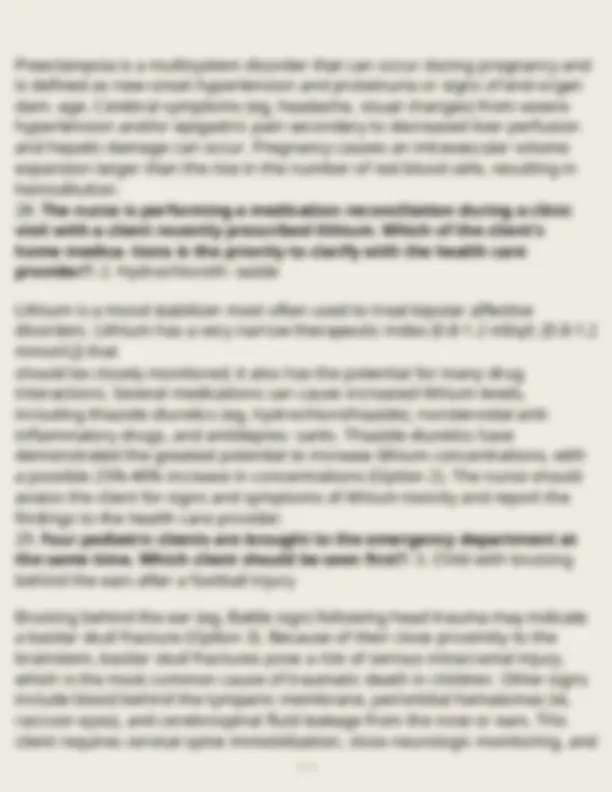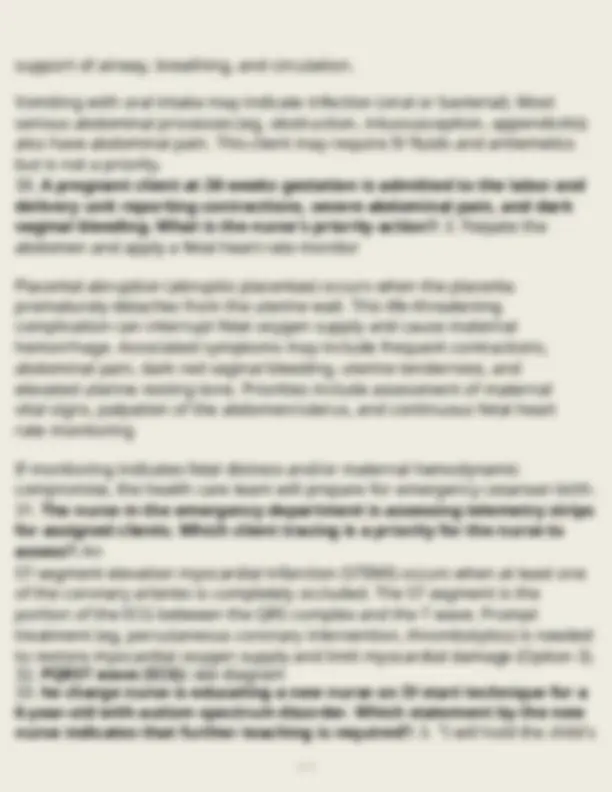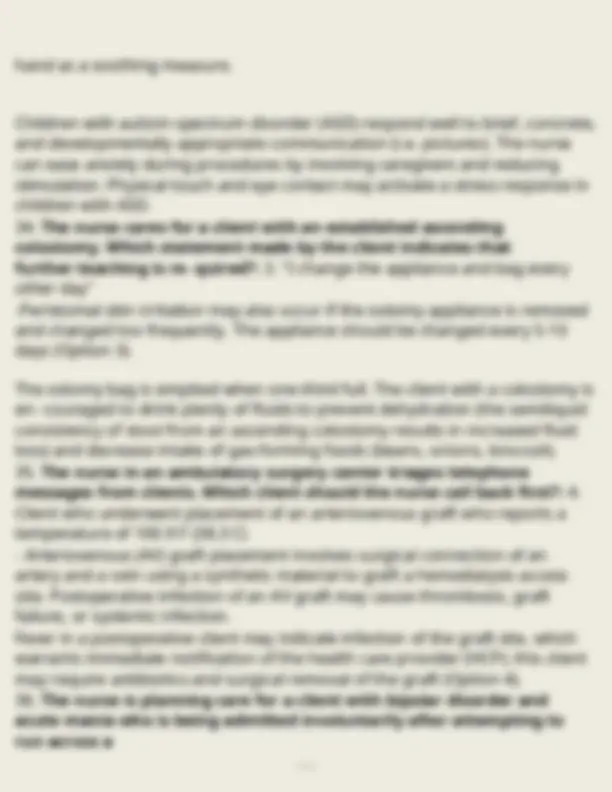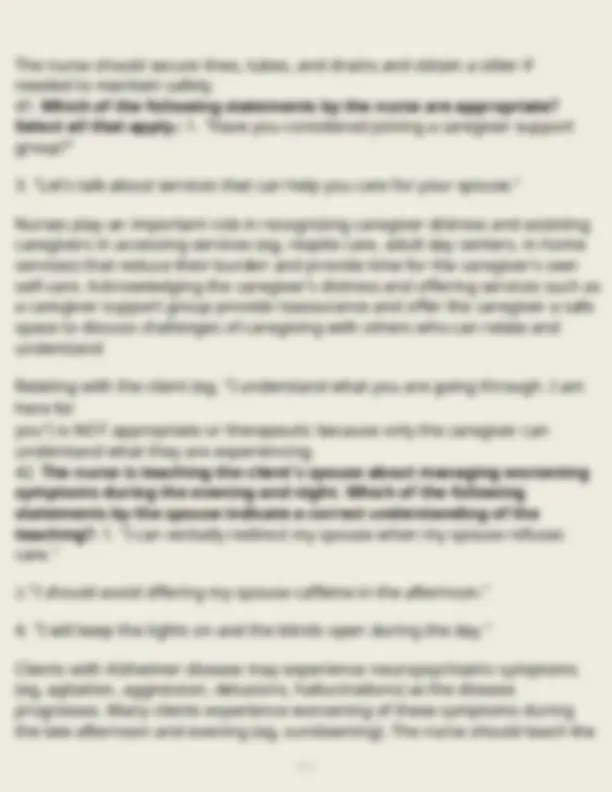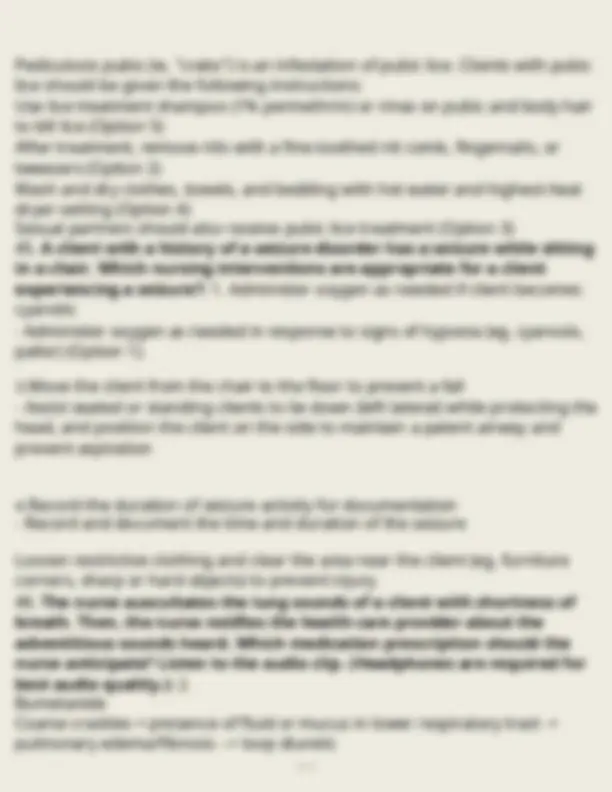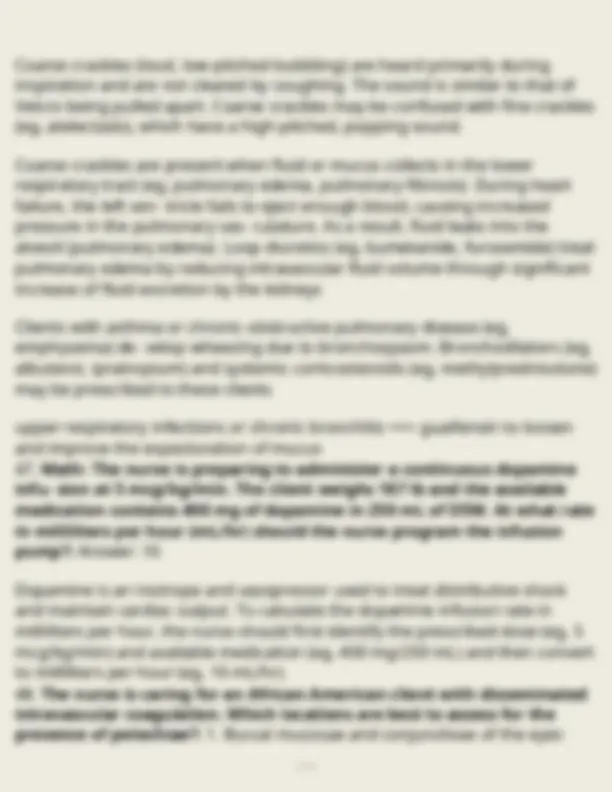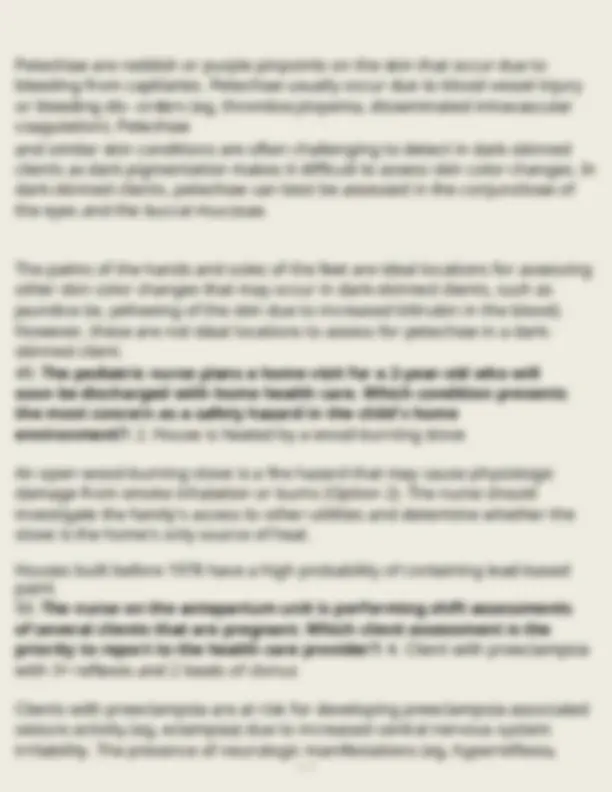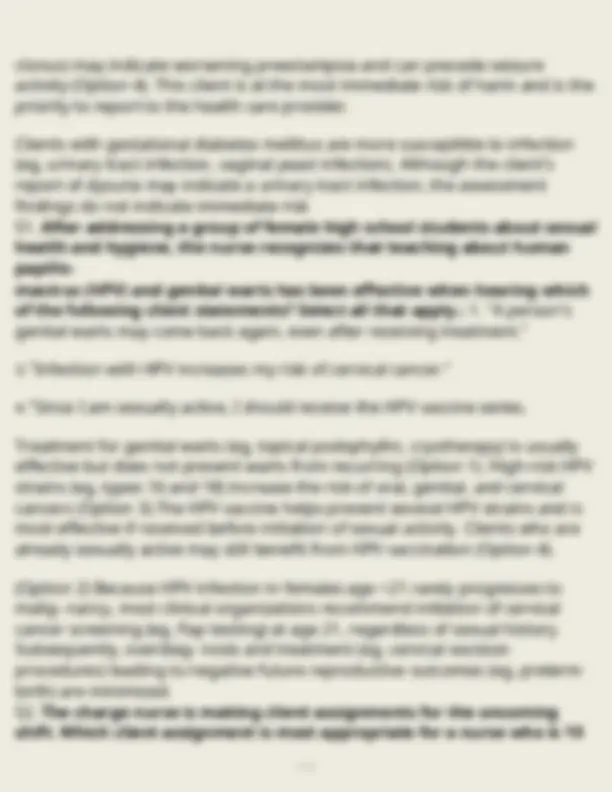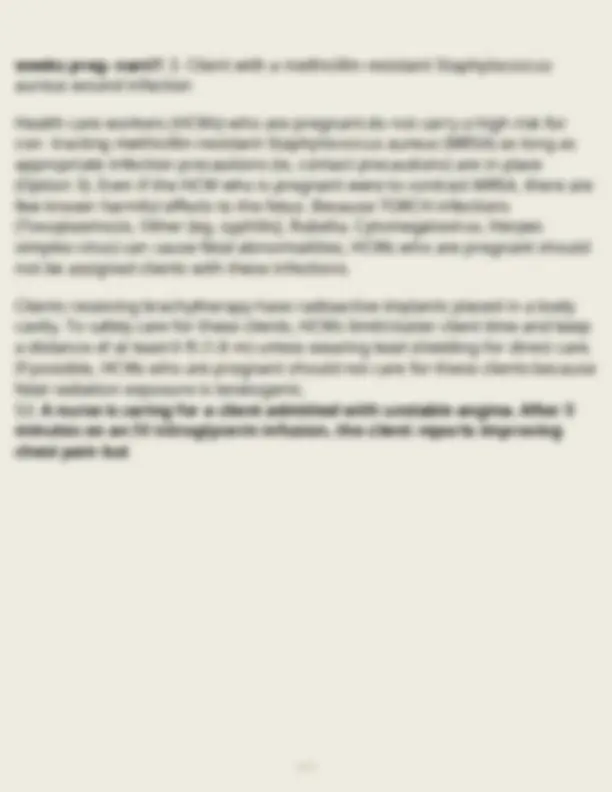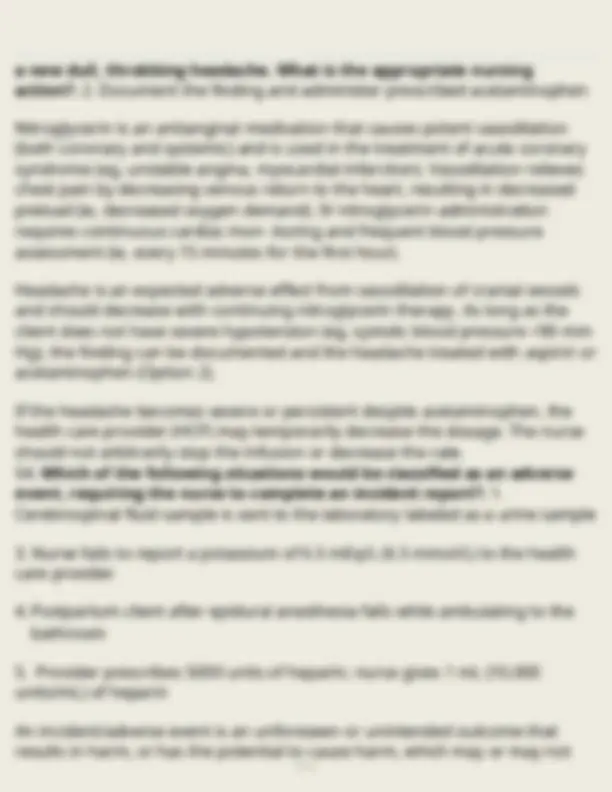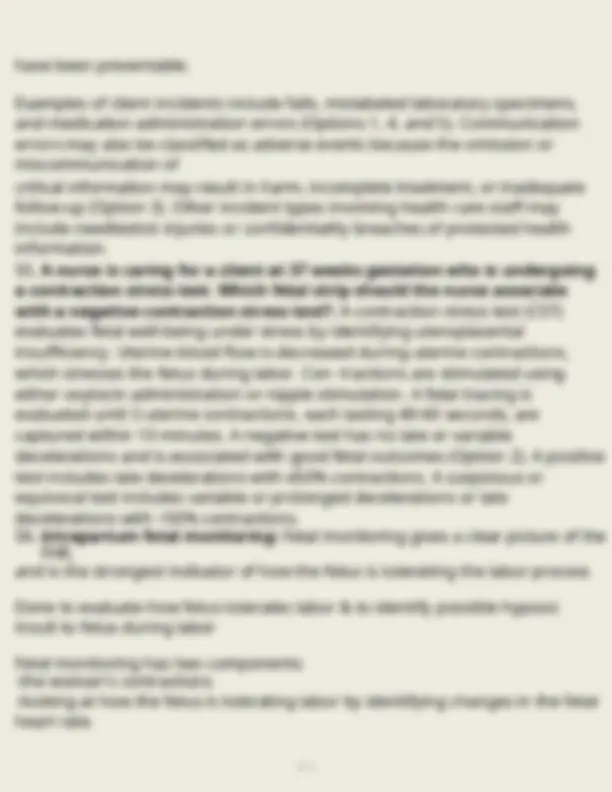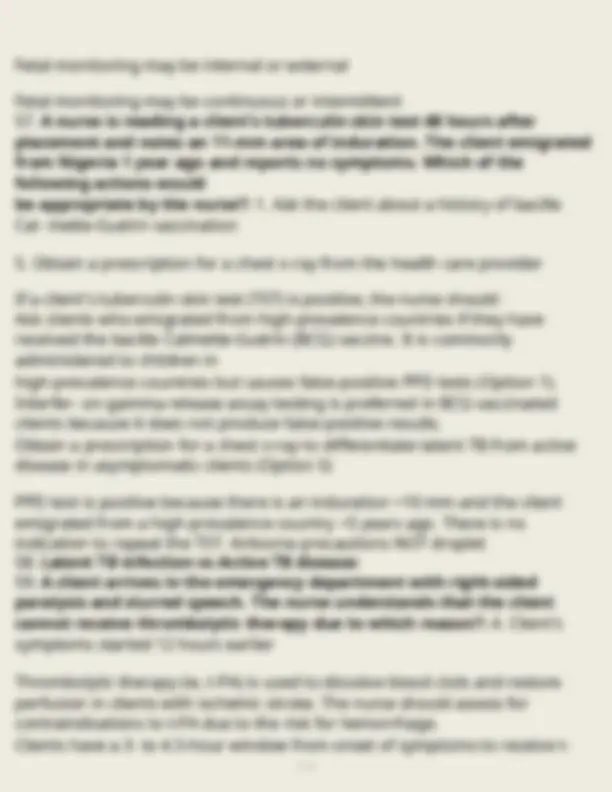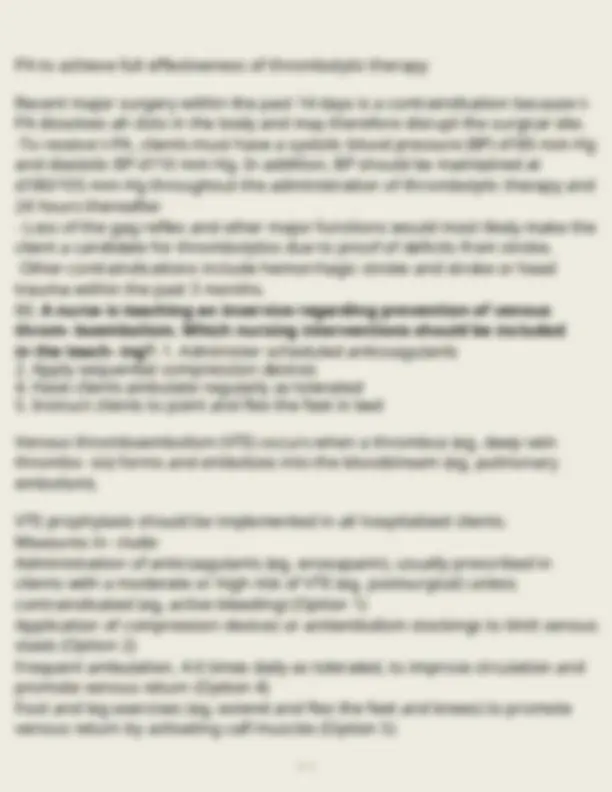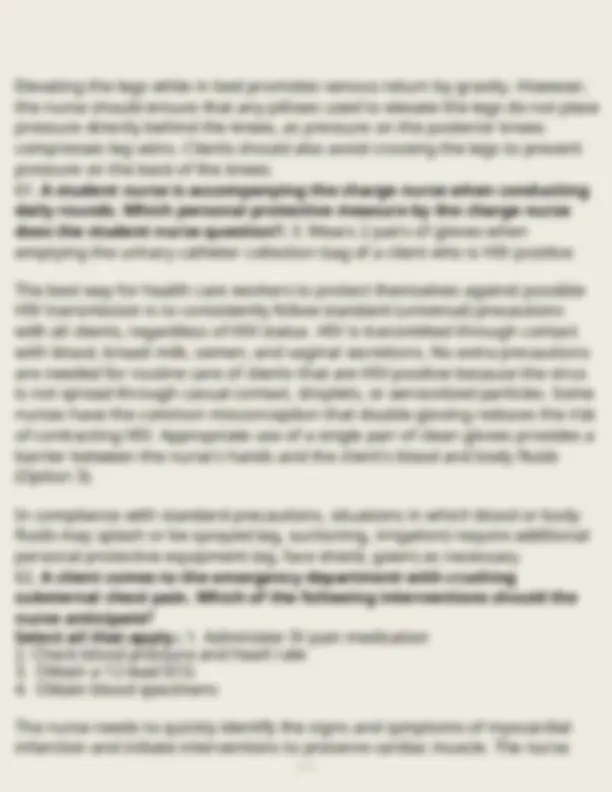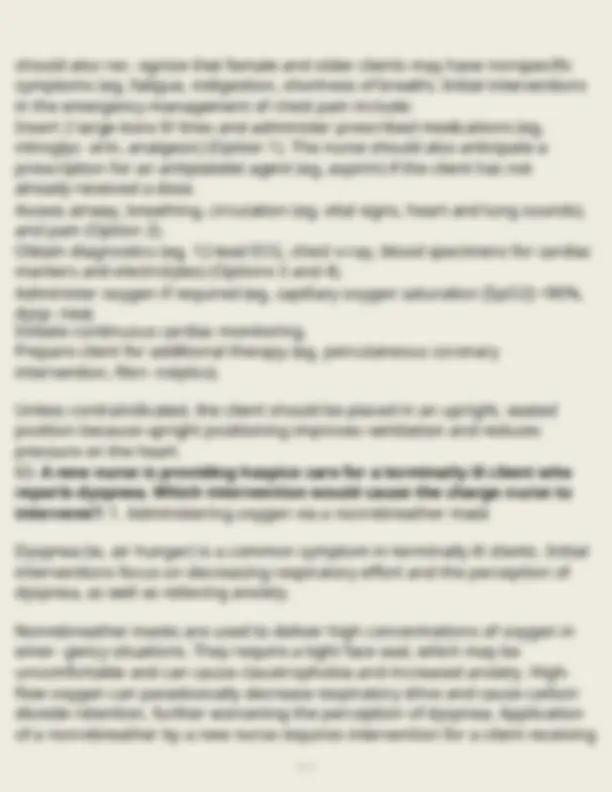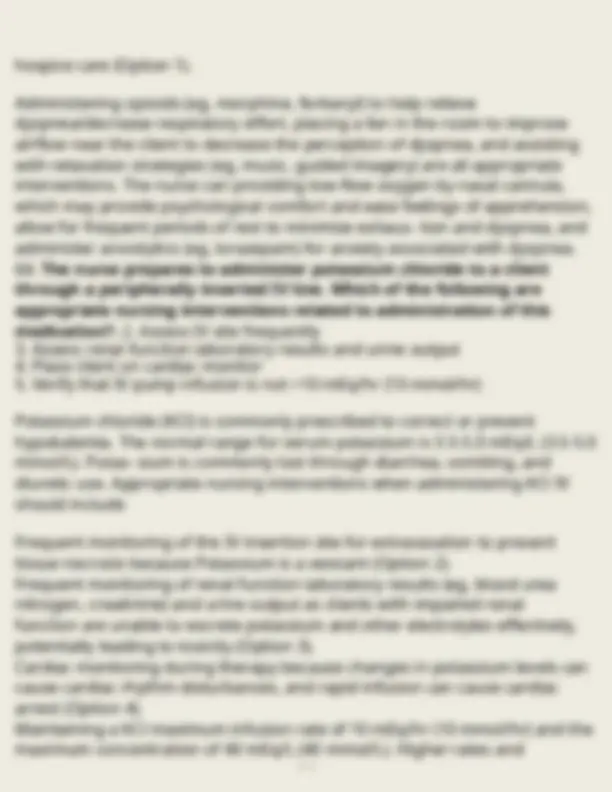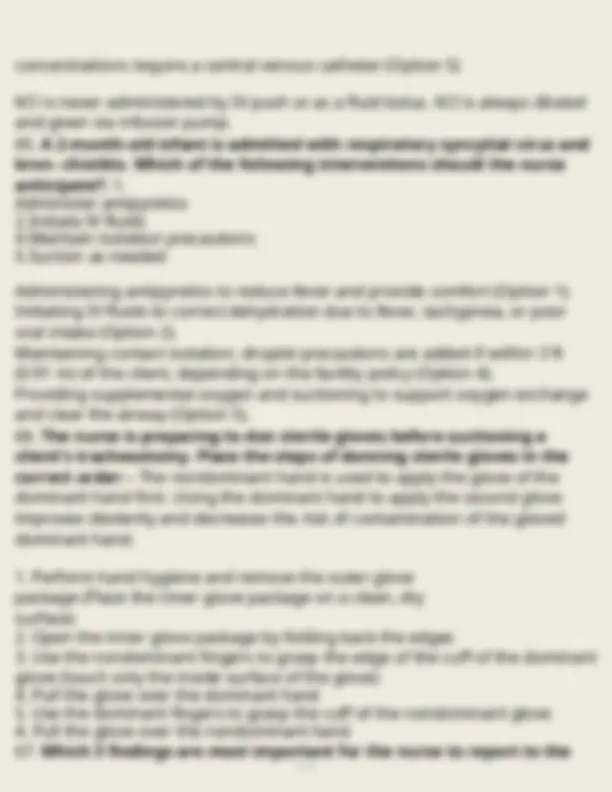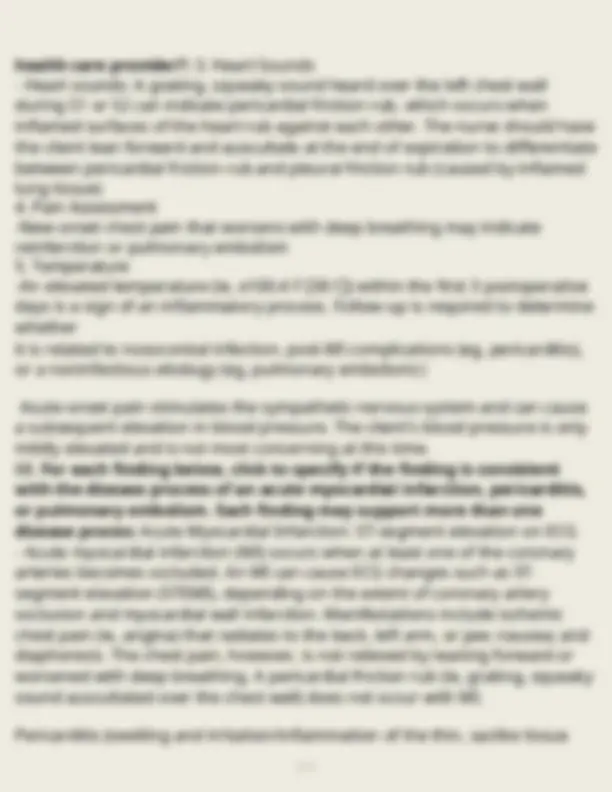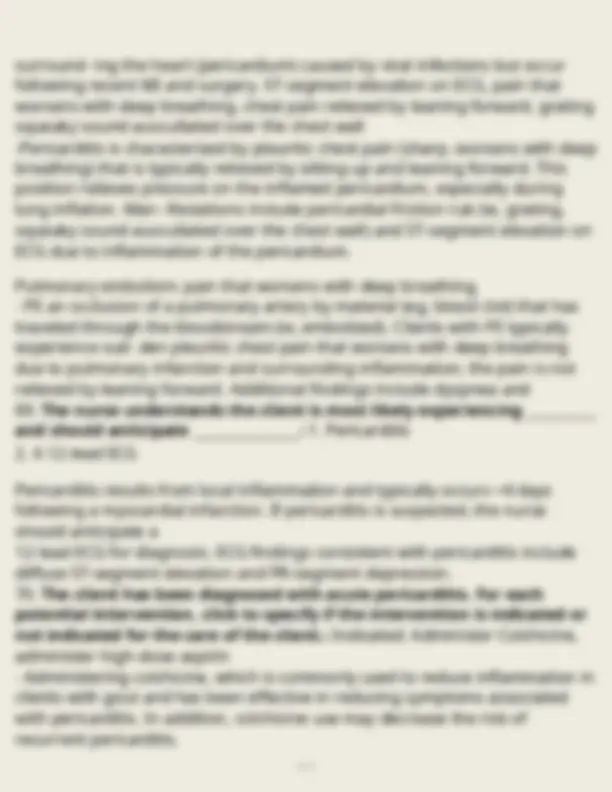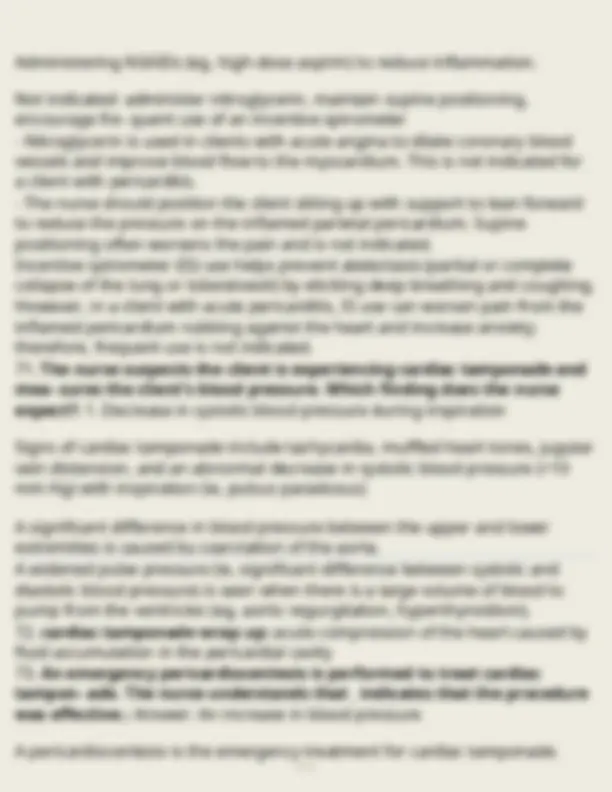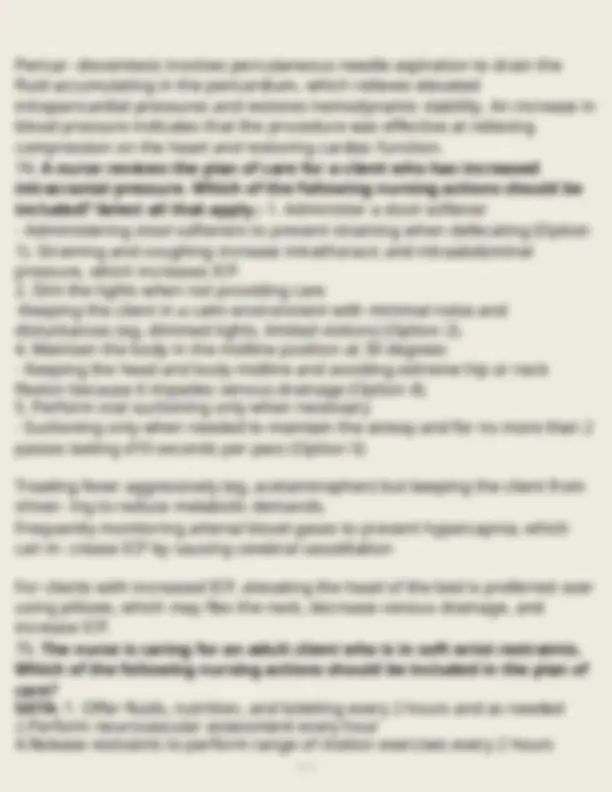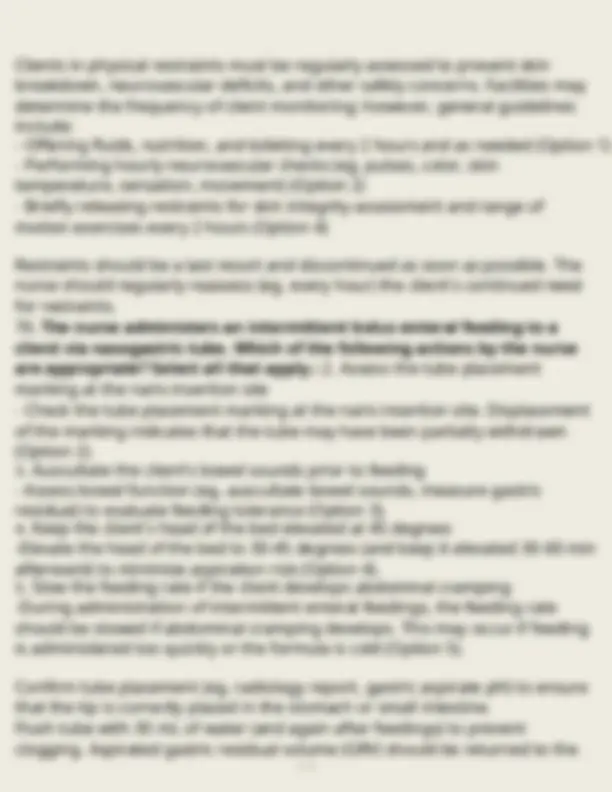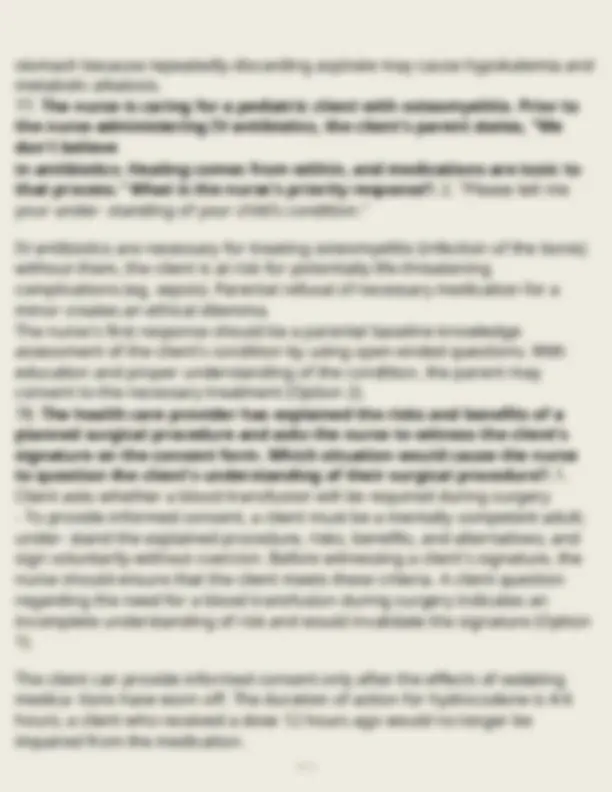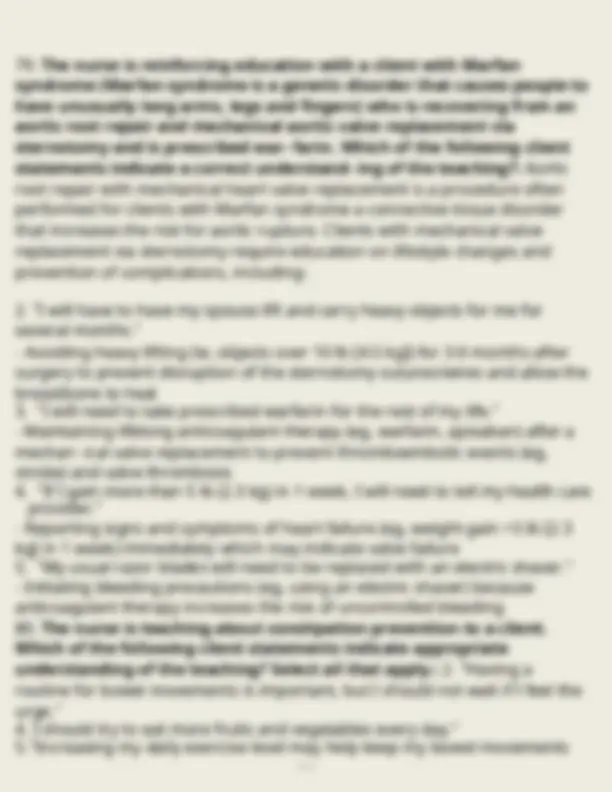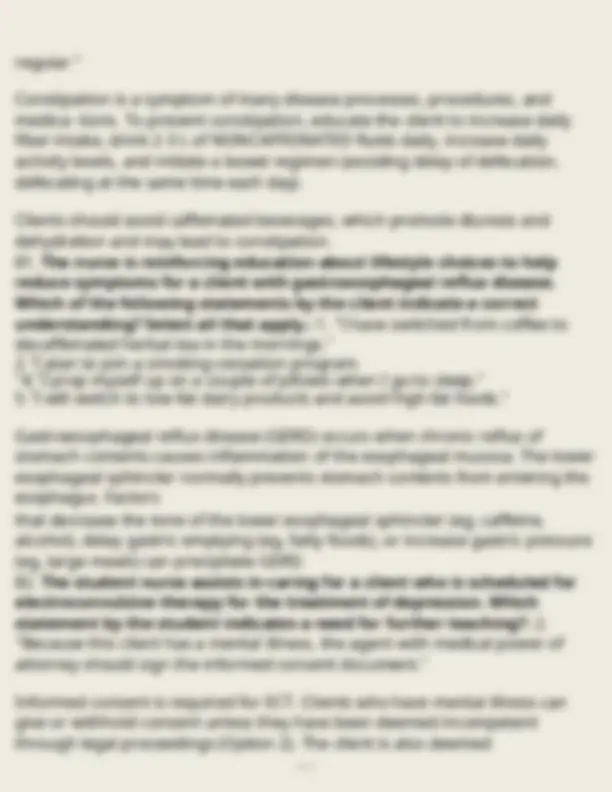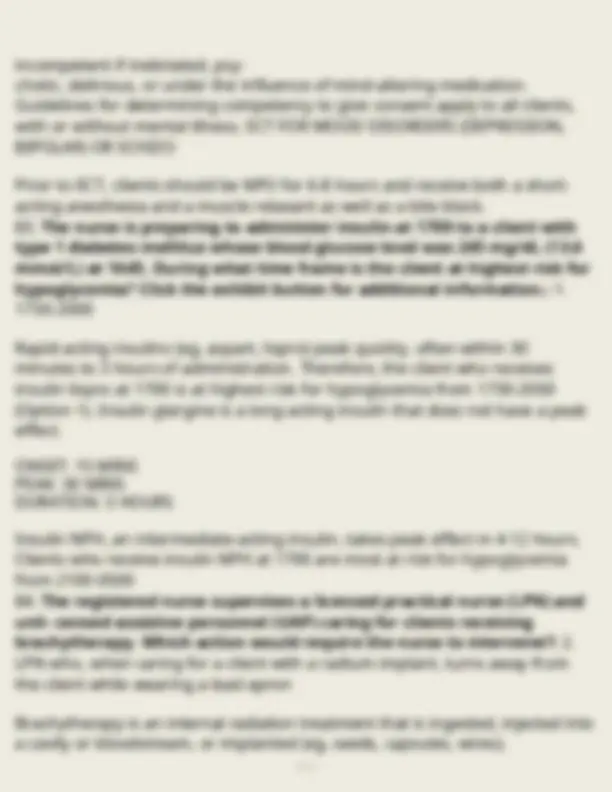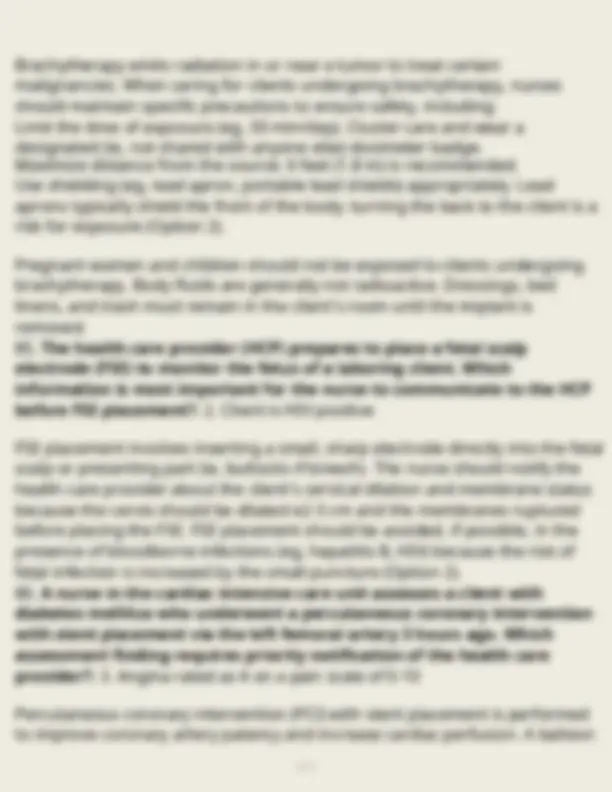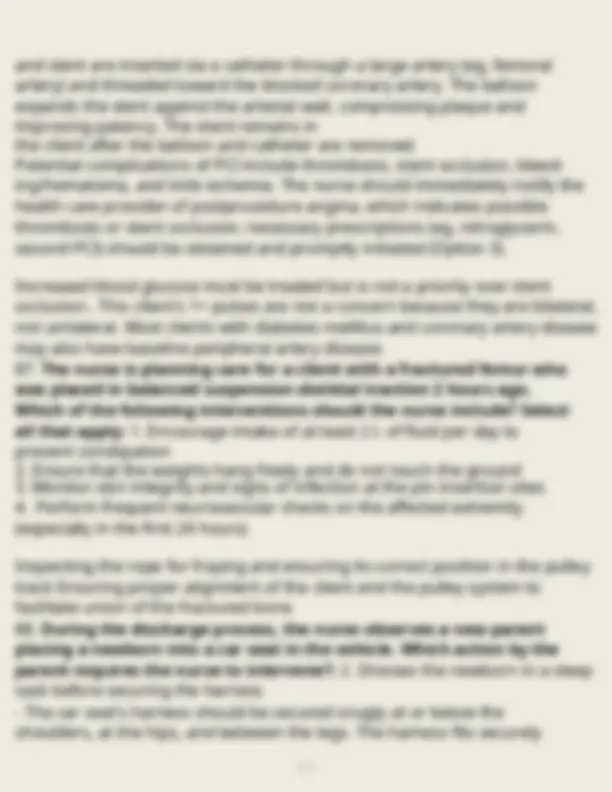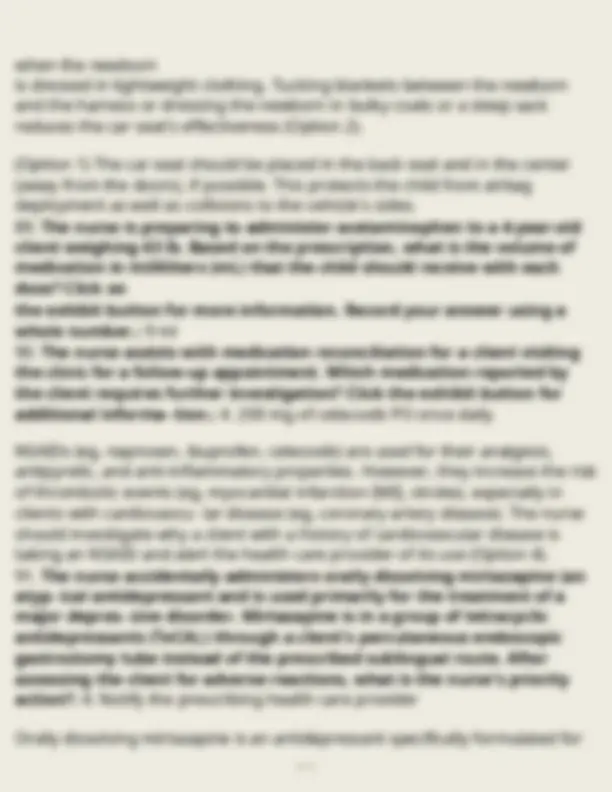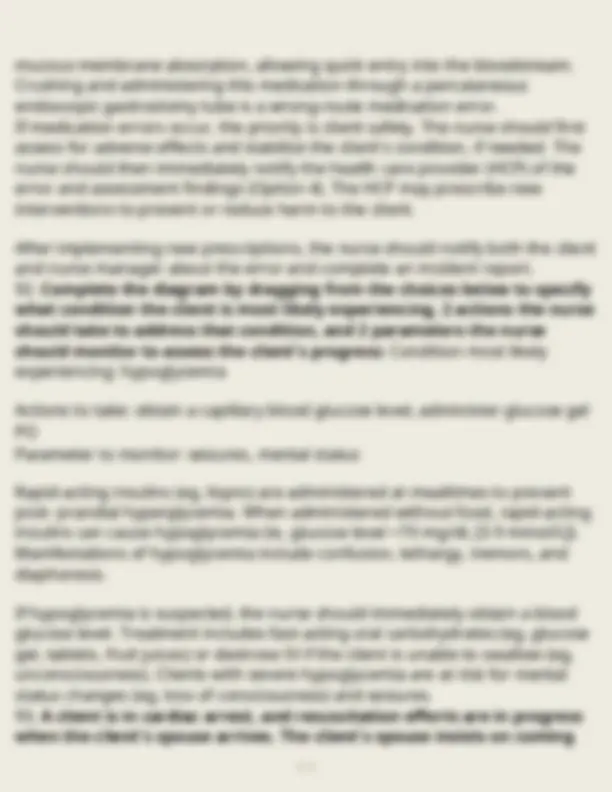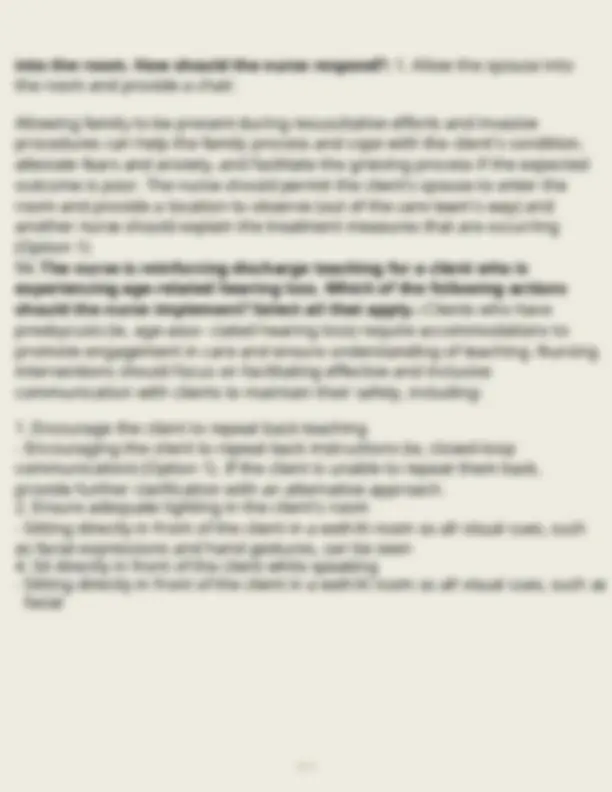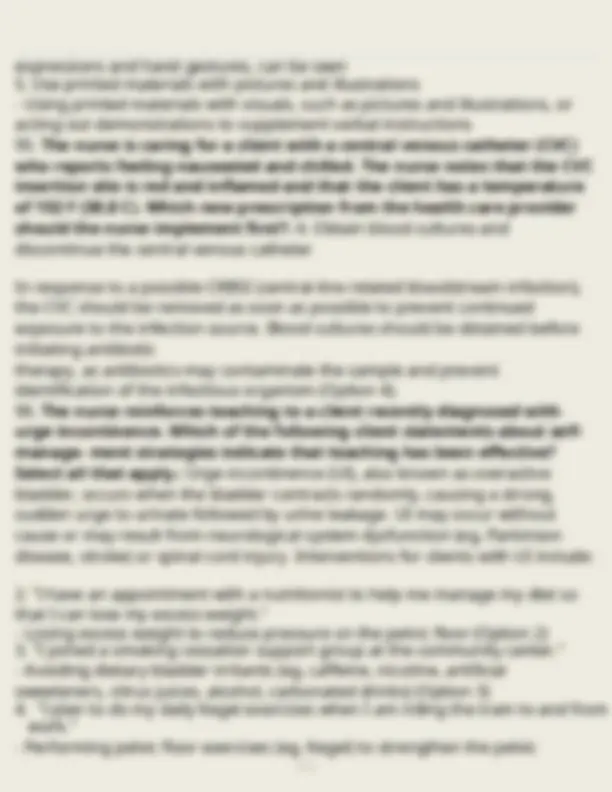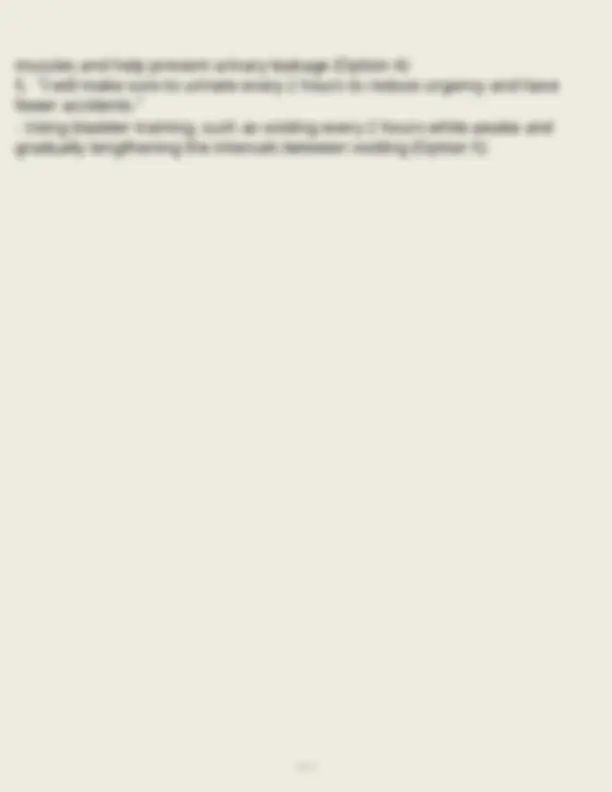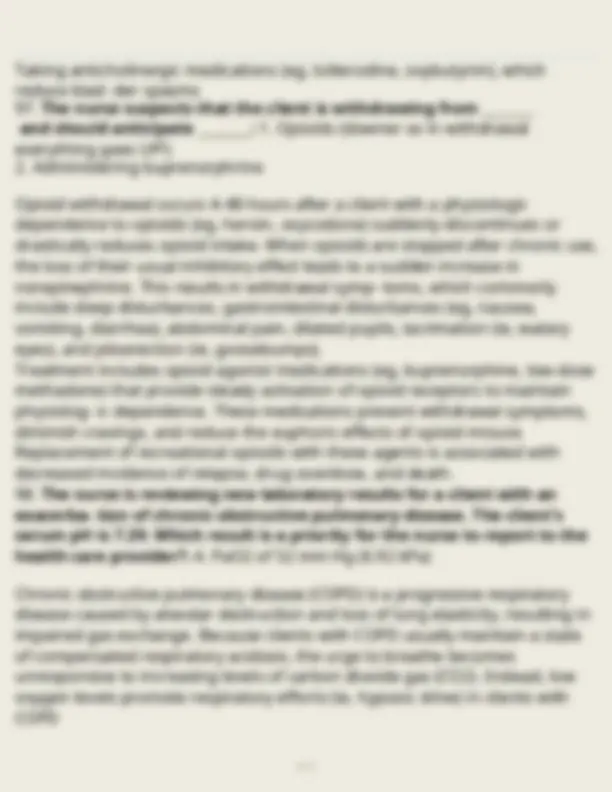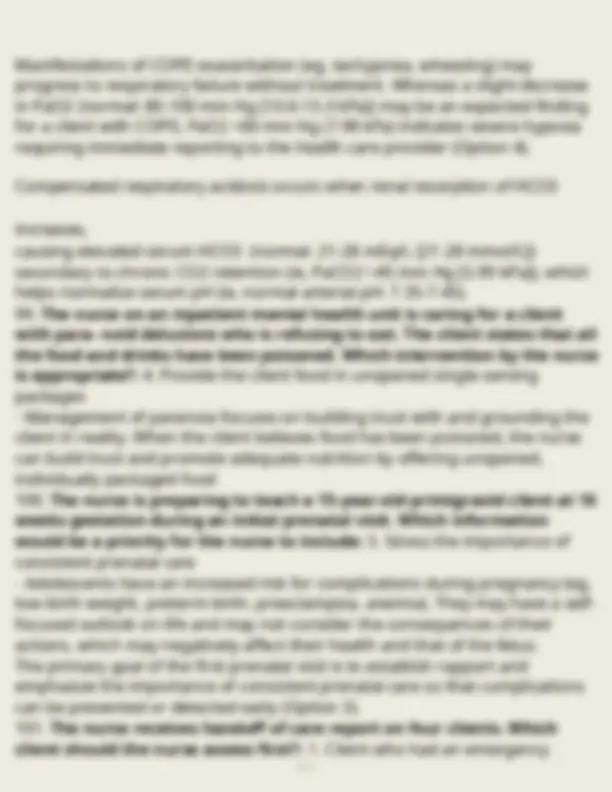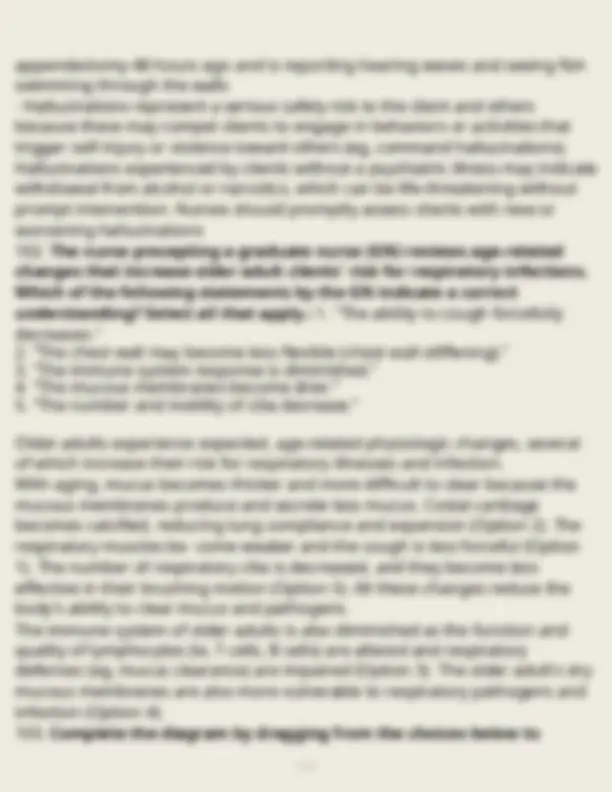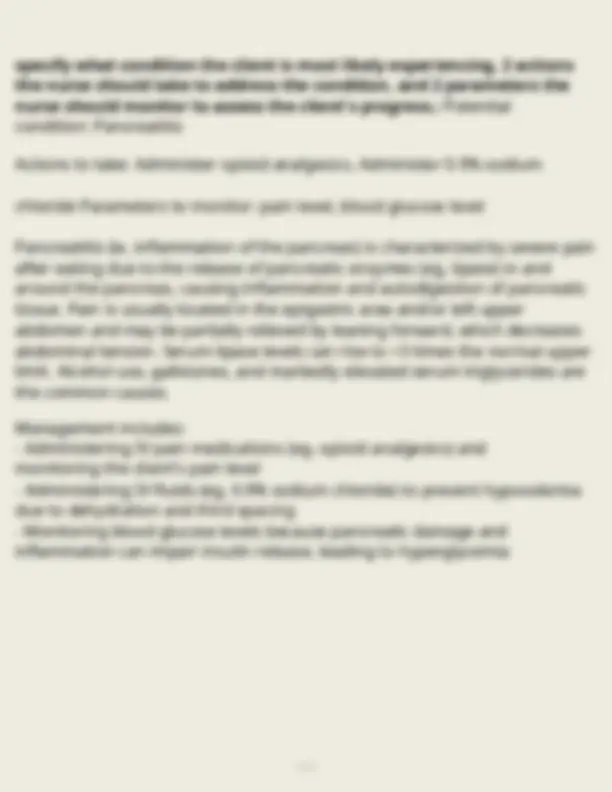Download NCLEX-RN Test 1 NGN PRACTICE QUESTIONS UPDATED VERSION WELL DETAILED /2024-2025 and more Exams Nursing in PDF only on Docsity!
NCLEX-RN Test 1 NGN PRACTICE QUESTIONS UPDATED
VERSION WELL DETAILED /2024-
- The nurse witnesses the collapse of a child while outdoors. The child is not breathing and has a pulse of 50/min. The nurse calls emergency services and initiates rescue breathing. After 2 minutes of rescue breaths, the child is still not breathing and is pale with a pulse of 30/min. What is the nurse's next action?: 1. Initiate chest compressions Rescue breathing is performed at a rate of 1 breath every 2-3 seconds. If the pulse remains <60/min and there are signs of poor perfusion (skin pallor), the nurse should initiate chest compressions and reassess the pulse every 2 minutes
- The charger nurse is responsible for making room assignments multiple clients. Which pari of client assignments to a shared room is appropriate?: 3. Client who had a bowel resection 1 day ago and client with asthma exacerbation. When making room assignments, it is important to remember that a client with an active or suspected infection should not be paired with a client who has a fresh surgical wound or is immunocompromised. A client having an asthma exacerbation does not have an infection and is not at risk for spreading infection to a client who had a recent bowel resection surgery.
- The clinic nurse is assessing a client who is being treated for depression and suicidal ideation. Which client statement best indicates that the client is not currently at risk for suicide?: 2. "I plan to attend my grandchild's graduation next month" Clients receiving treatment for depression and suicidal ideation must be carefully monitored for indications of increasing suicidal intent. During a client interview, the nurse should assess:
- Access to psychiatric medications
- Availability of help during a crisis (counselor, family)
- Future goals and plans
- Home and environment risks
- Overall affect and level of energy
- Possible access to weapons Clients who articulate long-term personal goals and family milestones are less likely to attempt death by suicide
- The nurse is caring for a client who had an anterior wall myocardial infarc- tion 2 days ago. The telemetry technician notifies the nurse at 8:30 AM that the client is in ventricular trigeminy. What is the nurse's priority intervention?: 1. Administer potassium supplement In ventricular trigeminy, premature ventricular contractions (PVCs) occur every third heartbeat. Myocardial injury (eg, myocardial infarction) predisposes the client to ectopy (eg, PVCs), which increases the client's risk for lethal dysrhythmias (eg, ven- tricular tachycardia). PVCs are caused and/or exacerbated by hypoxia, electrolyte imbalances, emotional stress, stimulants, fever, and exercise. This client's morning laboratory results show hypokalemia (potassium <3. mEq/L [3.5 mmol/L]); therefore, the priority is treatment of the underlying cause of the ectopy by administering the prescribed potassium replacement (Option 1). Health care providers (HCPs) often prescribe electrolyte replacement algorithms to clients at risk for electrolyte imbalances (eg, myocardial injury, receiving diuretics) unless a contraindication exists (eg, serum creatinine >1.5 mg/dL [133 μmol/L], anuric, weight <99.2 lb [45 kg]).
- The nurse cares for a client with a terminal disease who created a do not attempt resuscitation (DNAR) directive. The client stops breathing and loses their pulse. The client's adult child states, "Please, do whatever you can to save them!" Which intervention is appropriate?: 3. Explain the client's resuscitation directive to the client's child
blister, or shallow crater). The skin blisters or forms an open sore, and the area around the sore may be red and irritated. (shallow, open ulcer, red-pink wound with no sloughing and possible intact or ruptured blister) Stage 1: Intact skin with nonblanchable redness Stage 2: Partial-thickness skin loss (abrasion, blister, or shallow crater) involving the dermis or epidermis; the wound bed is red or pink and may be shiny or dry Stage 3: Full-thickness skin loss; subcutaneous fat is visible but not tendon, muscle, or bone; tunneling may be present Stage 4: Full-thickness skin loss with visible tendon, muscle, or bone; slough or eschar (scabbing, dead tissue) may be present; undermining and tunneling may be present Pressure injuries are described as "unstageable" if the base is covered by necrotic tissue or eschar
- A client with type 1 diabetes mellitus has prescriptions for NPH insulin and regular insulin. At 0730, the client's blood glucose level is 322 mg/dL (17.9 mmol/L), and the breakfast tray has arrived. What action should the nurse take? Click the exhibit button for additional information.: 4. Administer 37 units of insulin: 25 units of NPH mixed with 12 units of regular insulin in the same syringe, drawing up the regular insulin first Intermediate-acting insulins (NPH) can be safely mixed with short-acting (regular) and rapid-acting (eg, lispro, aspart) insulins in one syringe. Regular insulin should be drawn into the syringe before intermediate-acting insulin to avoid cross-contam- inating multidose vials (mnemonic - RN: Regular before NPH). To prepare the mixed dose: Inject 25 units of air into the NPH insulin vial without inverting the vial or passing the needle into the solution. Inject 12 units of air into the regular insulin vial and withdraw the dose, leaving no air bubbles. Draw 25 units of NPH insulin, totaling 37 units in one syringe. Any overdraw of NPH into the syringe will necessitate wasting the entire quantity.
- A client is receiving packed RBCs intravenously through a double- lumen peripherally inserted central catheter (PICC) line. During the transfusion, the nurse receives a new prescription to begin intravenous piggyback (IVPB) amphotericin B. What is the nurse's best action?: 4. Wait 1 hour after blood transfusion finishes administering amphotericin B Amphotericin B is an antifungal medication used to treat systemic fungal infections. It is commonly associated with severe adverse effects, including hypotension, fever, chills, and nephrotoxicity. Due to the similarity between the adverse effects of amphotericin B and the symptoms of a blood transfusion reaction (eg, chills, fever, hypotension, kidney injury), the nurse's best action is to complete the blood trans- fusion and allow one hour of observation before initiating amphotericin B (Option 4). This enables the nurse to distinguish between transfusion-related reactions and adverse effects from amphotericin B.
- Findings that require further investigation in a client with penetrating stab wounds to the neck, chest, and/or abdomen include:: Unilateral chest wall expansion (one side of the chest expands more than the other) and diminished breath sounds, which indicate the presence of air (eg, open pneumothorax) or fluid in the pleural space (eg, hemothorax, pleural effusion) Vital sign instability (eg, tachycardia, hypotension, tachypnea, hypoxemia) and signs of poor perfusion (eg, skin pallor), which are concerning for hemorrhage and respiratory compromise
- For each finding below, click to specify if the finding is consistent with the disease process of hemothorax or tension pneumothorax. Each finding may support more than one disease process.: Hemothorax: results from the accumulation of blood loss in the pleural cavity --> loss of intravascular blood vlolume: tachycardia, hypotension, unilateral diminished breath sounds Pneumothorax is characterized by air inside the pleural space, which disrupts the negative pressure that maintains lung expansion, causing the lung to collapse either partially or completely. Tension pneumothorax develops if air
clean, gloved hand firmly over the site until a dressing can be obtained
- The client's chest tube is reinserted and connected to a new water seal drainage system. Which of the following observations require follow-up with the health care provider? Select all that apply.: 1. 150 mL sanguineous output 1 hour after chest tube reinsertion
- The presence of excess blood (>100 mL/hr of sanguineous output) in the collection chamber indicates possible hemorrhage from the stab wound or a complication of chest tube insertion (eg, lung rupture) (
- Continuous bubbling in the water seal chamber --> indicates an air leak Intermittent bubbling (eg, during expiration) is expected in the water seal chamber until the pneumothorax is resolved; however, continuous bubbling indicates an air leak. Continuous, gentle bubbling is expected in the suction control chamber, which maintains and controls suction to the chest drainage system Diminished breath sounds on the affected side, tidaling, and pleuritic pain are expected findings.
- There has been a major disaster involving a manufacturing plant explo- sion. The emergency department nurse is sent to triage victims. Which client should the nurse send to the hospital first?: WRONG
- Client with a broken, protruding right tibia and gray, pulseless foot When prioritizing clients for treatment, emergent needs should be managed first, followed by urgent and then nonurgent. The client with an open fracture and impaired distal perfusion (eg, absent distal pulses, capillary refill >3 sec) has an emergent need for care as limb loss may occur without rapid intervention A large, open head wound and a Glasgow Coma Scale score of 3 is indicative of severe neurological trauma. This client has a poor prognosis regardless of treatment (expectant) and would be the lowest priority.
- After listening to the parents' reports and seeing the following
pediatric clients, the nurse knows that which client demonstrates signs of abuse that may necessitate mandatory reporting?: 4. 5-year-old whose x-ray reveals 1 new and 2 healed humerus fractures after falling from a tree Signs of abuse may include: Shaken baby syndrome (ie, irritability or lethargy, poor feeding, emesis, seizures) Burns in the shape of household items (eg, iron, spatula), from cigarettes, or from immersion in scalding liquid Repeated injuries in varied stages of healing (eg, bruises, burns, fractures) (Option 4) Injuries to genitalia Lapsed time between the injury and the time when care is sought Inconsistency between the injury and the caregiver's explanation of the injury (eg, client's developmental age, mechanism of injury)
- The nurses on a medical-surgical unit maintain a public social media page. Which of the following social media posts written by a nurse breaches client confidentiality? Select all that apply.: 1. "I private-messaged everyone a cute story about our sweet client with dementia."
- "It breaks my heart that our paraplegic client was so neglected by her husband."
- "The client in room 5 is positive for influenza, so please remember your flu vaccines!"
- "Wash your hands well if you had room 4 this week! Cultures are positive for Clostridioides difficile."
- The nurse caring for a male client prepares to insert an indwelling uri- nary catheter. The nurse assesses for allergies, explains the procedure to the client, and asks unlicensed assistive personnel to perform perineal care while equipment is gathered. Place in order the steps the nurse should take when inserting the urinary catheter. All options must be used.: 1. Perform hand hygiene and open sterile urinary catheterization kit
weight loss and electrolyte imbalances; therefore, the client should be taught to measure daily weights.
- When the nurse provides education about starting risperidone, which statement by the client's parent indicates a need for further teaching?: - WRONG
- It is normal for the client to become shaky and restless when agitated." Second-generation (atypical) antipsychotic medications (eg, risperidone/Risperidal, quetiapine/Seroquel, olanzapine/Zyprexa) are used to treat schizophrenia, bipolar disorder, and other mental health disorders. One of the main adverse effects the nurse should recognize with second- genera- tion antipsychotic medications is extrapyramidal symptoms (EPSs). EPSs include manifestations of akathisia (ie, restlessness, fidgeting), parkinsonism (eg, tremors, shuffling gait), and tardive dyskinesia (eg, lip smacking, facial grimacing). These symptoms are important to monitor because they may be easily mistaken for agitation or negative schizophrenic symptoms (eg, pacing, rocking) (Option 4). The health care provider may prescribe anticholinergics (eg, benztropine/Cogentin, diphenhydramine/Benadryl) or benzodiazepines to treat EPSs. The nurse should teach that the sedating effects of second-generation antipsychotic medications (eg, drowsiness, hypersomnia [ie, excessive daytime sleepiness]) are common.
- The staff nurse caring for a client with a history of substance use disorder approaches the charge nurse and says, "My client is constantly requesting pain medicine. I had to administer normal saline instead of morphine because it is too early for another dose of morphine." Which action by the charge nurse is the priority at this time?: 3. Instruct the nurse to notify the health care provider about the lack of pain relief
Administration of a placebo (a substance with no therapeutic effect) outside of a con- sented research trial is unethical and deceitful. When faced with an ethical dilemma, the nurse should address the client's needs prior to reporting or documenting the unethical behavior. Clients with a history of substance use disorder and increased opioid tolerance often require a higher-dose analgesic or stronger opioid (eg, hydromorphone) to achieve pain relief. The priority action by the charge nurse is to instruct the staff nurse to contact the health care provider to discuss the client's frequent requests for morphine to alleviate uncontrolled pain
- A nurse receives change-of-shift report on four clients. Which client should the nurse assess first?: 3. Client with a bowel resection receiving total parenteral nutrition who had 4800 mL of urine output over the past 12 hours Total parenteral nutrition (TPN) is an IV nutrition feeding that may be prescribed to clients with dysfunction of the gastrointestinal tract (eg, short bowel). Glucose (dextrose) is a primary component of TPN solutions; therefore, the nurse should monitor blood glucose and assess for symptoms of hyperglycemia (eg, polydipsia, polyuria, headaches, blurred vision). A urine output of 4800 mL over the past 12 hours (ie, 400 mL/hr) may indicate hyperglycemia (Option 3). Symptomatic clients should be assessed and treated immediately because hyperglycemia can lead to seizures, coma, or death.
- An elderly client with chronic kidney disease is admitted with urosepsis. Based on the admitting diagnosis and laboratory results, which prescriptions would the nurse question? Select all that apply. Click on the exhibit button for additional information.: 2. Continue home dose of valsartan -Chronic kidney disease impairs the excretion of excess potassium and can poten- tiate hyperkalemia, which can lead to life-threatening arrhythmias (eg, ventricular fibrillation). ACE inhibitors (eg, lisinopril, ramipril) or angiotensin II receptor blockers (eg, valsartan, losartan, irbesartan) can be used to manage
Preeclampsia is a multisystem disorder that can occur during pregnancy and is defined as new-onset hypertension and proteinuria or signs of end-organ dam- age. Cerebral symptoms (eg, headache, visual changes) from severe hypertension and/or epigastric pain secondary to decreased liver perfusion and hepatic damage can occur. Pregnancy causes an intravascular volume expansion larger than the rise in the number of red blood cells, resulting in hemodilution.
- The nurse is performing a medication reconciliation during a clinic visit with a client recently prescribed lithium. Which of the client's home medica- tions is the priority to clarify with the health care provider?: 2. Hydrochloroth- iazide Lithium is a mood stabilizer most often used to treat bipolar affective disorders. Lithium has a very narrow therapeutic index (0.8-1.2 mEq/L [0.8-1. mmol/L]) that should be closely monitored; it also has the potential for many drug interactions. Several medications can cause increased lithium levels, including thiazide diuretics (eg, hydrochlorothiazide), nonsteroidal anti- inflammatory drugs, and antidepres- sants. Thiazide diuretics have demonstrated the greatest potential to increase lithium concentrations, with a possible 25%-40% increase in concentrations (Option 2). The nurse should assess the client for signs and symptoms of lithium toxicity and report the findings to the health care provider.
- Four pediatric clients are brought to the emergency department at the same time. Which client should be seen first?: 3. Child with bruising behind the ears after a football injury Bruising behind the ear (eg, Battle sign) following head trauma may indicate a basilar skull fracture (Option 3). Because of their close proximity to the brainstem, basilar skull fractures pose a risk of serious intracranial injury, which is the most common cause of traumatic death in children. Other signs include blood behind the tympanic membrane, periorbital hematomas (ie, raccoon eyes), and cerebrospinal fluid leakage from the nose or ears. This client requires cervical spine immobilization, close neurologic monitoring, and
support of airway, breathing, and circulation. Vomiting with oral intake may indicate infection (viral or bacterial). Most serious abdominal processes (eg, obstruction, intussusception, appendicitis) also have abdominal pain. This client may require IV fluids and antiemetics but is not a priority.
- A pregnant client at 38 weeks gestation is admitted to the labor and delivery unit reporting contractions, severe abdominal pain, and dark vaginal bleeding. What is the nurse's priority action?: 3. Palpate the abdomen and apply a fetal heart rate monitor Placental abruption (abruptio placentae) occurs when the placenta prematurely detaches from the uterine wall. This life-threatening complication can interrupt fetal oxygen supply and cause maternal hemorrhage. Associated symptoms may include frequent contractions, abdominal pain, dark red vaginal bleeding, uterine tenderness, and elevated uterine resting tone. Priorities include assessment of maternal vital signs, palpation of the abdomen/uterus, and continuous fetal heart rate monitoring If monitoring indicates fetal distress and/or maternal hemodynamic compromise, the health care team will prepare for emergency cesarean birth.
- The nurse in the emergency department is assessing telemetry strips for assigned clients. Which client tracing is a priority for the nurse to assess?: An ST-segment elevation myocardial infarction (STEMI) occurs when at least one of the coronary arteries is completely occluded. The ST segment is the portion of the ECG between the QRS complex and the T wave. Prompt treatment (eg, percutaneous coronary intervention, thrombolytics) is needed to restore myocardial oxygen supply and limit myocardial damage (Option 3).
- PQRST wave (ECG): see diagram
- he charge nurse is educating a new nurse on IV start technique for a 6-year-old with autism spectrum disorder. Which statement by the new nurse indicates that further teaching is required?: 3. "I will hold the child's
five-lane highway. Which intervention is the priority to include in the care plan?: 3. Offer high-calorie snacks the client can eat while on the move and during tasks When caring for a client with mania, the nurse should prioritize physiological needs over psychological or self-fulfillment needs. The nurse can address imbalanced nutrition in a manic client by providing high-calorie snacks and finger foods that the client can carry and eat without having to sit down. Bipolar disorder is character- ized by alternating episodes of depression and mania. Manic clients demonstrate hyperactivity and distractibility and may refuse to sit still long enough to drink or eat, placing them at risk for inadequate nutritional intake.
- Click to highlight below the 2 findings that are a safety concern.: 1. Clients may forget to take medications due to cognitive decline, limited hand mobility, and sensory alterations. This can be problematic because older adults often have various health conditions and take multiple medications. Clients can have difficulty remembering familiar faces and the surrounding environ- ment; they will often become disoriented (eg, wandering and lost in the neighbor- hood). This becomes a safety risk because they are unable to find their way back home and can become lost for long periods of time. Becoming more withdrawn indicates the client may be feeling depressed. The nurse should assess for other symptoms of depression (eg, hopelessness, loss of pleasure); however, this finding does not pose an immediate safety concern.
- For each characteristic below, click to specify if the characteristic is con- sistent with the disease process of Alzheimer disease or delirium.: Alzheimer Disease: irreversible, hallucinations, speech changes (word-finding difficulties_ Delirium: acute onset, hallucinations, speech changes Alzheimer disease is an irreversible, progressive form of dementia. Speech changes, and memory and social skills slowly decline as the disease
progresses, while hallucinations tend to appear later in the course of the disease. Delirium is an acute, reversible, alteration in mental state involving a reduced or fluctuating level of consciousness, speech changes, and hallucinations.
- Complete the following sentence by choosing from the list of options. The nurse suspects the client's condition is caused by: Neurodegenerative changes in the brain Alzheimer disease (AD) is caused by neurodegenerative changes in the brain. As individuals age, some develop insoluble amyloid plaques in the brain tissue. Amyloid plaques cause an inflammatory response that leads to cell damage and neuron death in surrounding areas. In clients with AD, more plaques are apparent, especially in areas of the brain that are essential for memory and cognitive function (eg, hippocampus). Ultimately, plaques will involve other areas of the brain, including the parts responsible for language and reasoning (eg, cerebral cortex). In addition to excess amyloid plaques, clients with AD also have abnormal accumu- lations of twisted protein (tau) that collect inside nerve cells and cause neuronal death. The brain will eventually shrink by the final stage of the disease.
- The client is attempting to remove a newly inserted peripheral IV. Which of the following interventions are appropriate at this time? Select all that apply.: 2.Ask the unlicensed assistive personnel to stay with the client until a sitter is available 3.Play the client's favorite music and look at family photos together 4.Reassure the client that this is a safe environment 5.Reinforce the IV insertion site dressing with gauze Clients with moderate-stage Alzheimer disease (AD) may develop disruptive be- haviors as they become unable to communicate their needs. When a client with AD is agitated or aggressive, the nurse should assess for and resolve causes of discomfort, provide distraction, and reassure the client.
caregiver about techniques to reduce distress and manage symptoms of sundowning, including: Verbally redirecting the client when the client refuses care. Redirection shifts the client's attention from a distressing situation and eases their anxiety and frustration (Option 1). Promoting a normal daytime/nighttime cycle by restricting caffeine later in the day, and increasing daytime exposure to light (eg, keeping lights on/blinds open) encourages a normal circadian rhythm (Options 2 and 4).
- The nurse conducts a developmental assessment of a 4-year-old child. Which of the following tasks does the nurse anticipate that the child will perform successfully?: 1. Draw a circle
- Use a spoon and fork
- Walk up and down the stairs Preschool-age children begin to master more gross motor activities while rapidly increasing their fine motor abilities. The preschooler age 4 should have the fine motor skills to manipulate small tools (eg, scissors, pencil) and therefore be able to draw simple shapes (eg, circle, square) and perform more self-care activities (eg, eating with a spoon and fork) (Options 1 and 4). The gross motor skills and balance of a child age 4 improve, allowing for more independent, complex movements (eg, walking up and down stairs) (Option 5). It is normal for preschool-age children to be unable to sit quietly for longer than 15 minutes at a time. Jump rope: age 5
- The nurse in the public health clinic is caring for a client with pubic lice. Which of the following statements should the nurse include in the education? Select all that apply.: 2. Remove nits from pubic hair with a fine- toothed nit comb." 3."Sexual partners should also receive treatment." 4."Wash clothes and linens with hot water." 5."Wash pubic hair with lice treatment shampoo."
Pediculosis pubis (ie, "crabs") is an infestation of pubic lice. Clients with pubic lice should be given the following instructions: Use lice treatment shampoo (1% permethrin) or rinse on pubic and body hair to kill lice (Option 5) After treatment, remove nits with a fine-toothed nit comb, fingernails, or tweezers (Option 2) Wash and dry clothes, towels, and bedding with hot water and highest-heat dryer setting (Option 4) Sexual partners should also receive pubic lice treatment (Option 3)
- A client with a history of a seizure disorder has a seizure while sitting in a chair. Which nursing interventions are appropriate for a client experiencing a seizure?: 1. Administer oxygen as needed if client becomes cyanotic
- Administer oxygen as needed in response to signs of hypoxia (eg, cyanosis, pallor) (Option 1). 3.Move the client from the chair to the floor to prevent a fall
- Assist seated or standing clients to lie down (left lateral) while protecting the head, and position the client on the side to maintain a patent airway and prevent aspiration 4.Record the duration of seizure activity for documentation
- Record and document the time and duration of the seizure Loosen restrictive clothing and clear the area near the client (eg, furniture corners, sharp or hard objects) to prevent injury.
- The nurse auscultates the lung sounds of a client with shortness of breath. Then, the nurse notifies the health care provider about the adventitious sounds heard. Which medication prescription should the nurse anticipate? Listen to the audio clip. (Headphones are required for best audio quality.): 2. Bumetanide Coarse crackles = presence of fluid or mucus in lower respiratory tract -< pulmonary edema/fibrosis --> loop diuretic

